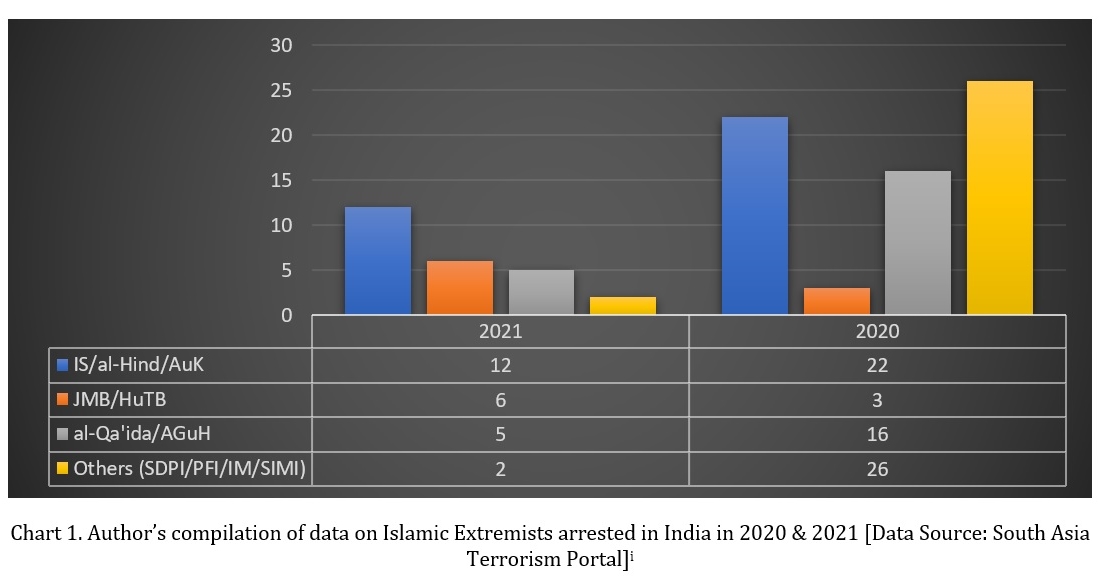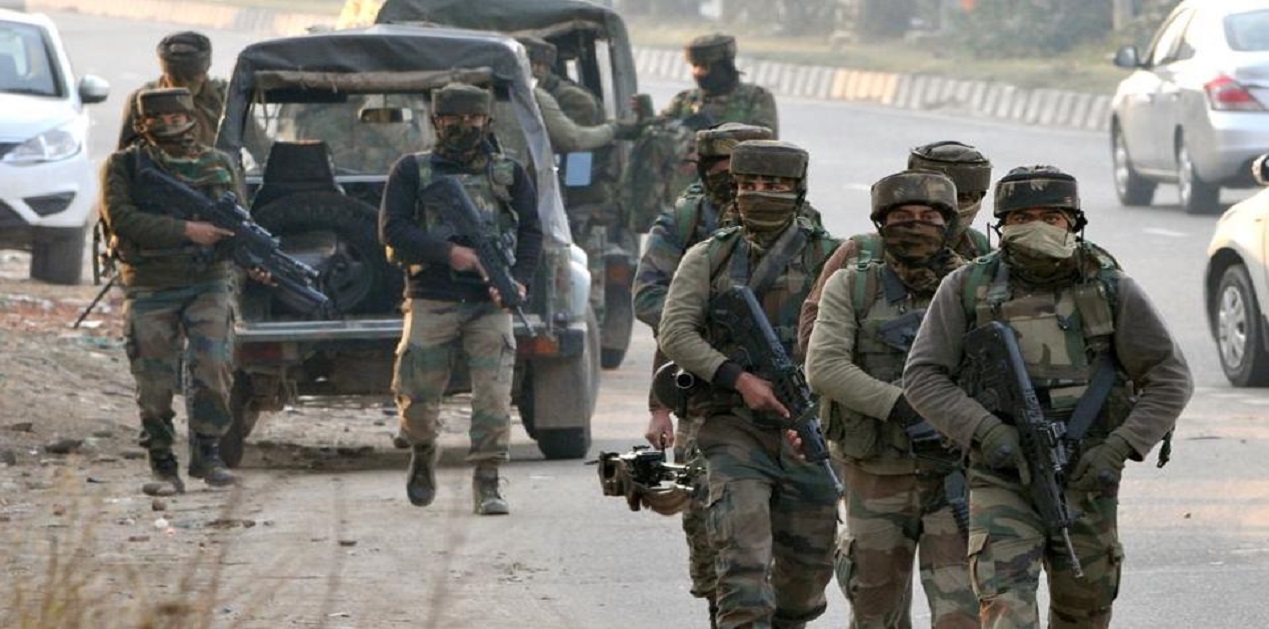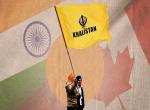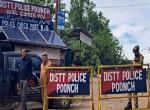Despite the outbreak of the China-origin coronavirus aka COVID-19 in late 2019 and the continuation of this fatal virus spread globally in 2020, the year 2021 has witnessed the continuation in the terrorism-related incidents, linked directly or indirectly, with several geopolitical events worldwide. This write-up is the first part of the ‘Year-End Review’ series on terrorism-related developments in India (national) and worldwide (international). The first segment, National, attempts to provide an overview of key terrorism-related activities in 2021 and the likely impact of those events carried forward to the year 2022. This review highlights the terrorism-related incidents reported in India and is categorised further into four primary categories—i) Jammu and Kashmir (J&K), ii) Left-Wing Extremism (LWE), iii) Islamic Extremism, and iv) Khalistan-inspired Extremism. Further this segment looks at the critical scenarios in the four abovementioned categories, followed by the prognosis for 2022.
Jammu & Kashmir (J&K)
For the last three decades, the Indian Union Territory (UT) of Jammu and Kashmir (J&K) has been affected by Pakistan’s proxy war against India in the form of state-sponsored terrorism across the border. Post-abrogation of Article 370 and 35A on 05 August 2019, the coordination between the security forces has significantly improved the security situation in the Valley. India’s zero-tolerance policy towards terrorism has resulted in the elimination of many terrorists, including key commanders of terror groups, from the J&K. Unlike the years before 2020, the year 2021 did not witness any major terrorist attack or protest by the organised anti-India elements in the State.

In 2021, around 460 terrorism-related incidents were recorded (as compared to 415 in 2020), out of which 153 were gun-battle between the security forces and terrorists. According to the data highlighted in Table 1, around 45 security forces personnel attained Veergati (fell in the battle) compared to 56 in 2020. The decline in the number of security forces attaining Veergati highlights the significant improvisation in training and effective implementation of counter-terrorism strategies in the operations.
In 2021, around 193 terrorists, including 44 key commanders of various terror groups, were killed in counter-terrorism (CT) operations, whereas in 2020, the numbers were 232. Among 44 key terrorists belonging to Pakistan-supported terrorist groups, 26 were of Lashkar-e-Taiba (LeT), 10 of Jaish-e-Mohammad (JeM), 07 of Hizb ul-Mujahideen (HM), and one of al-Badr.[1] The data highlights the reduced presence of terrorists in the Valley compared to the preceding years. According to a top J&K police official, around 134 youth had joined terrorist groups in 2021; among 134 terrorists, 72 were neutralised, and 22 were arrested.[2]
On 13 December 2021, terrorists of ‘Kashmir Tigers’—a shadow terrorist group of Jaish-e-Mohammad (JeM) indiscriminately fired on a police bus of the 9th Battalion of J&K police’s armed wing in Budgam district of J&K. In the attack, three policemen attained Veergati, while 11 others were injured. It was the first major attack on security forces’ convoy post-Pulwama attack in 2019.[3]
By late-2021, terrorists started targeting people from Kashmiri Pandit, Hindu, and Sikh communities. From June to November 2021, there were three terrorism-related incidents in the Srinagar district, where five people from said communities lost their lives.[4] However, robust security and intelligence grids have been organised to ensure the safety of people of J&K. Overall, despite the rise in terrorism-related incidents in 2021 as compared to 2020, J&K witnessed improved security situation on the ground, marking the decreased number of fatalities of security forces personnel and civilians, and reduced induction of youth into terrorism from the Valley.
Left Wing Extremism (LWE)
Since 2004, the Left-Wing Extremism (LWE), aka Naxalism, led by the Communist Party of India (Maoist) or CPI (Maoist), has been responsible for major attacks on security forces and killings of civilians in India. The CPI (Maoist) is banned and enlisted in the Schedule of Terrorist Organisations, along with all its manifestations under India’s Unlawful Activities (Prevention) Act [UA(P)A], 1967. In different capacities, the LWE affected States are Chhattisgarh, Jharkhand, Odisha, Bihar, West Bengal, Andhra Pradesh, Telangana, Maharashtra, Uttar Pradesh, and Kerala.

In 2021, around 557 LWE-related incidents occurred (as compared to 675 in 2020), out of which 124 incidents were anti-Maoist operations in the LWE-affected regions in which 51 security personnel attained Veergati, and 128 Maoists were eliminated. Compared to the fatalities of security personnel in 2020, 2021 recorded a minuscule increase in the counts. However, there has been an overall improvement in the LWE situation, which can be attributed to the increased presence of the security forces, with better operational strategy and welfare schemes for the people living in the LWE-affected areas.

Referring to the data shown in Table 3, 2021 witnessed success in the development strategies implemented in the LWE-affected areas. Compared with data available for 2020, there has been a significant increase of 51 per cent in the number of Maoists surrendered in 2021. In 2021, around 533 Maoists lay down their weapons and joined the various rehabilitation programmes. For example, in the Dantewada district of Chhattisgarh, many Maoists had surrendered and joined the State police’s rehabilitation drive— ‘Lon Varratu’. Since the launch of the ‘Lon Varratu’ campaign in June 2020, around 475 Maoists, including 119 ‘most-wanted’, have surrendered. The ‘Lon Varratu’ is a term in the local Gondi dialect for return to own home or village.[5] The surrendered Maoists claimed that the hollow ideologies of the LWE had brainwashed them for years.
In 2021, around 409 Maoists were arrested compared to 276 in 2020. The rise in the counts of Maoists surrenderees and arrested highlights the effective operational strategies on the ground, which further persuade ‘brainwashed’ Maoists to leave the violence and join the welfare programmes for the development of society. The State government of LWE-affected regions, with support from the Central government, has been continuously working on implementing several welfare initiatives, which gives positive results in dealing with the LWE problem.
Islamic Extremism
In India, the terrorist attacks inspired by Islamic extremism have declined. Post-2019 Pulwama attack in J&K, the rest of India did not witness any significant terrorist attack by Islamic extremists in 2021. However, at the beginning of the year, on 29 January 2021, a low-intensity explosion took place outside the Israeli Embassy in Delhi. No injuries to the staff of the embassy were caused due to the explosion. The incident was linked with the 29th anniversary of establishing diplomatic relations between India and Israel. The NIA undertook the investigation, and on 24 June 2021, the Special Cell of Delhi Police arrested four suspects from the Ladakh region in connection with the explosion.[6]
With the loss of territorial grip in Iraq and Syria by late 2017, the Islamic State (IS) has been looking for its expansion in Africa and Afghanistan through its affiliated groups and planning for attacks in the region. However, the hopes of IS finding a solid base within India through sleeper cells or lone-wolves have not borne any fruit so far. In December 2019, the Union Ministry of Home Affairs (MHA) informed the Lok Sabha that law-enforcement agencies arrested around 120 terrorists of Jamaat ul-Mujahideen Bangladesh (JMB) during the period 2014-2019.[7]
 [8]
[8]
Chart 1 represents the data of Islamic extremists— other than Lashkar-e-Taiba (LeT), Hizb ul-Mujahideen (HM), and Jaish-e-Mohammad (JeM) arrested in various operations in 2020 and 2021. Compared to the 67 extremists or terror operatives arrested in 2020, law-enforcement agencies arrested around 25 individuals of various groupsin 2021. Compared to the data of 2020, law-enforcement agencies arrested 12 Islamic State terrorists in 2021. However, there has been an increase in the arrest of terrorists of JMB and its affiliated group recorded in 2021. It highlights the infiltration of JMB operatives into West Bengal and further spreading out in various parts of the country. In a news report of 12 July 2021, a senior official of the Special Task Force (STF) of Kolkata Police had confirmed that at least 15 JMB operatives managed to enter West Bengal from the neighbouring country—Bangladesh, and at least 10 of them had moved to various part of India, including J&K, Odisha, and Bihar.[9]
Khalistan Inspired Extremism
In 2021, India did not witness any major Khalistan-inspired terror act or an incident. However, from 2001 onwards, there have been several incidents of low-intensity explosions and recovery of a cache of explosives or arms and ammunition in various areas in Punjab. The Khalistan-inspired extremist activities emerging out of the misleading idea of Khalistan—propagated by Pakistan, has increased in recent years. There are several indications to suggest that Pakistan’s Inter-Service Intelligence (ISI) Directorate has been supporting the pro-Khalistan activities and groups in India and other parts of the world, mainly the United States (US), Canada, and the United Kingdom (UK).
In 2019, Pakistan operationalised the Kartarpur Corridor, which allows Sikh pilgrims from India to visit the sacred site of Gurudwara Shri Kartarpur Sahib in Pakistan’s Punjab province. The event was a moment of joy and celebration for the Sikh community in India and abroad. However, from a national security perspective, the Kartarpur Corridor is also being used by Pakistan intelligence agencies to re-activate the Khalistan extremism against India.
On 13 January 2021, the designated terrorist and spokesperson for the SFJ—Gurpatwant Singh Pannu had tried to link the farmers’ protests with the infamous 1984 anti-Sikh riots. In a video released, Pannu announced a reward of USD 2.5 lakh for an individual whocould remove the Indian Tricolour and replace it with the Khalistan flag at the Red Fort on 26 January Republic Day.[10] During the 2020-2021 Farmers’ protest in Delhi, on 26 January 2021, tens of thousands of protestors deviated from the pre-sanctioned route and gathered at the Red Fort and central part of Delhi and resorted to violence and damaging the public property. Out of the gathering, few protestors reached the Red Fort and hoisted the Sikh religious flag on the mast of the rampart of the Red Fort.[11] In the clash between the police personnel and protestors, around 400 policemen got injured, and over 200 protestors were arrested.[12]
Prognosis for 2022
Comparative success of counter-terrorism operations in 2021 has highlighted the improved coordination between the security forces and intelligence agencies in the Jammu and Kashmir (J&K). The successful CT operations in the Valley have broken the ‘spine’ of major terrorist groups— LeT, JeM, and HM; however, their affiliated factions or off-shoot terror groups—The Resistance Force (TRF), Kashmir Tigers, and People’s Anti-Fascist Front (PAFF) would pose security challenges in 2022, unless dealt with stringent CT measures. Unlike other terror groups, these shadow groups are diversions orchestrated by Pakistan to ease the international pressure and avoid getting listed in the ‘black zone’ for supporting terror groups under the Financial Action Task Force (FATF)’s regulations.
The year 2021 witnessed mixed results in LWE-affected areas. Although the high numbers of Maoists who surrendered or arrested had given a jolt to the cadre, the Maoists will make efforts to re-build their operational capabilities in their areas of dominance. In 2022, the Maoist activities may slow down but pose a serious security challenge to the forces deployed in LWE-affected areas.
Since the inception of a new branch for South Asia— Wilayah al-Hind in May 2019, Islamic State has made some claims of clashes with security forces in J&K, with intentions to project its false presence in the Valley. The arrest of IS sympathisers from different parts of India, mainly Kerala, highlights the radicalisation and recruitment of Muslim youth. The arrested IS operatives confessed the critical role of content on various social media platforms that led to radicalisation. Despite the lack of much traction for Islamic State’s or al-Qa’ida’s ideology in India, the data of arrests made in 2021 points toward the ‘less-visible but highly effective’ problem of radicalisation that cannot be neglected. Also, the recent reports on Pakistan’s ISI-supported terror groups’, mainly LeT, approaching Rohingya camps in Bangladesh for radicalisation and recruitment is another area that the security and intelligence fraternity should consider as a grave concern.
On 10 February 2021, addressing the United Nations Security Council (UNSC)’s briefing on the 12th report of the Secretary-General, India emphasised Pakistan’s link with al-Qa’ida, Islamic State, and other terrorist groups and the threat posed by these terror groups to international peace and security. India’s envoy to the United Nations (UN)— Ambassador T S Tirumurti, stated that—
“We must not lose sight of the ease with which proscribed Haqqani Network (HQN) and its supporters, especially the Pakistani authorities, have worked along with prominent terrorist organisations such as al-Qaeda, ISIL, Tehrik-e-Taliban Pakistan (TTP), and other terror groups in South Asia.”[13]
In September 2021, India became a non-permanent member of the United Nations Security Council (UNSC) for 2021-2022. India’s experience in countering terrorism may play a significant role in UNSC’s policies against terrorism; notably, a consensus on India’s proposed Comprehensive Convention on International Terrorism (CCIT) is much anticipated. More numbers of terrorists arrested show the activeness of law-enforcement agencies in tracking and further foiling the plans of the terrorist groups.
The pro-Khalistan activities carried forward from 2021 may continue to pose challenges for Indian intelligence agencies. Despite the ban imposed on the SFJ’s website and its other manifestations, the presence of pro-Khalistan content on various forums, including Twitter, will be an issue of grave concern. A fruitful result is anticipated from the NIA officials visit and discussion with their Canadian counterparts in late 2021 regarding the investigation of the funding source of pro-Khalistan groups and activists. It is highly likely that in 2022, Pakistan’s ISI Directorate may try to re-activate terror groups that may orchestrate low-level terror attacks in Punjab.
Endnotes :
[1]PTI, “184 ultras killed in J&K in 2021, 44 of top rung, 20 foreigners among them: DGP”, The Times of India, 04 January 2022, Available from: https://timesofindia.indiatimes.com/india/184-ultras-killed-in-jk-in-2021-44-of-top-rung-20-foreigners-among-them-dgp/articleshow/88615177.cms. Accessed on 06 January 2022.
[2]Ibid.
[3]Jagota, Naval and Anurag Sharma. “VIF News Digest: National Security-Defence Studies & Terrorism, 01-15 December 2021”, Vivekananda International Foundation, 27 December 2021, Available from: https://www.vifindia.org/defensenationalsecurityterrorism/2021/december/27 . Accessed on 06 January 2022.
[4]Lok Sabha. Killing of Minorities by terrorists- Unstarred Question no. 1447, (India: 2021), Available from: http://164.100.24.220/loksabhaquestions/annex/177/AU1447.pdf . Accessed on 06 January 2022.
[5]Jagota, Naval and Anurag Sharma. “VIF News Digest: National Security- Defence Studies & Terrorism, 01-15 December 2021”, Vivekananda International Foundation, 27 December 2021, Available from: https://www.vifindia.org/defensenationalsecurityterrorism/2021/december/27 . Accessed on 06 January 2022; PTI. “16 Maoists surrendered in Chhattisgarh’s Dantewada: Police”, NDTV, 04 December 2021, Available from: https://www.ndtv.com/india-news/16-maoists-surrender-in-chhattisgarhs-dantewada-police-2637147 . Accessed on 06 January 2022.
[6]ANI, “Delhi Police Special Cell arrests 4 students from Kargil in connection with Israel Embassy blast case”, ANI, 24 June 2021, Available from: https://www.aninews.in/news/national/general-news/delhi-police-special-cell-arrests-4-students-from-kargil-in-connection-with-israel-embassy-blast-case20210624180638/ . Accessed on 07 January 2022.
[7]Lok Sabha. Arrest of Terrorists of Jamaat ul-Mujahideen Bangladesh-Unstarred Question No. 1813 (India: 2019), Available from: https://pqars.nic.in/annex/250/AU1813.docx . Accessed on 07 January 2022.
[8]Note: In Chart 1. Islamic State (IS) and its affiliates al-Hind & Ansar ul-Khilafa (Kerala) [AuK]; Jamaat ul-Mujahideen Bangladesh (JMB) and its affiliate—Hizb ut Tahrir (Bangladesh) [HuTB]; al-Qa’ida and its affiliate—Ansar Ghazwat ut-Hind (AGuH); and Others Islamic Extremist/Fundamentalist Organisations—Popular Front of India (PFI), IM (Indian Mujahideen), Social Democratic Party of India (SDPI), and Students’ Islamic Movement of India (SIMI).
[9]PTI. “15 JMB terrorists entered India, moved to Kashmir and other States: official”, The Hindu, 13 July 2021, Available from: https://www.thehindu.com/news/national/15-jmb-terrorists-entered-india-moved-to-kashmir-and-other-states-official/article35291567.ece . Accessed on 08 January 2022.
[10]Sehgal, Manjeet. “Khalistan terror group SFJ instigates farmers in Delhi to remove tricolour on Republic Day”, India Today, 13 January 2021, Available from: https://www.indiatoday.in/india/story/khalistan-terror-group-sfj-instigates-farmers-in-delhi-to-remove-tricolour-on-republic-day-1758674-2021-01-13 . Accessed on 10 January 2022.
[11]PTI. “Republic Day Violence: Delhi Police Register 4 FIRs for rioting, damage to public property”, News 18, 26 January 2021, Available from: https://www.news18.com/news/india/republic-day-violence-delhi-police-register-four-cases-against-farmers-3343367.html . Accessed on 10 January 2022.
[12]Lama, Prawesh. “Tractor Rally chaos: FIRs filed under attempt to murder, criminal conspiracy”, Hindustan Times, 27 January 2021, Available from: https://www.hindustantimes.com/cities/delhi-news/tractor-rally-chaos-firs-filed-for-attempt-to-murder-destroying-evidence-101611739955413.html . Accessed on 10 January 2022.
[13]Tirumurti, T S. “UNSC briefing on ‘Threats to International Peace and Security Caused by Terrorist Acts’”, United Nations Security Council (UNSC), 10 February 2021, Available from: https://pminewyork.gov.in/IndiaatUNSC?id=NDE1OQ . Accessed on 08 January 2022.; Jagota, Naval and Anurag Sharma. “VIF News Digest: National Security- Defence Studies & Terrorism, 01-15 February 2021”, Vivekananda International Foundation, 27 February 2021, Available from: https://vifindia.org/defensenationalsecurityterrorism/2021/february/27. Accessed on 10 January 2022.
(The paper is the author’s individual scholastic articulation. The author certifies that the article/paper is original in content, unpublished and it has not been submitted for publication/web upload elsewhere, and that the facts and figures quoted are duly referenced, as needed, and are believed to be correct). (The paper does not necessarily represent the organisational stance... More >>
Image Source: https://i.redd.it/xn1d8qnggef01.jpg











Post new comment